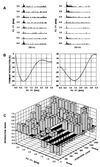Orderly cortical representation of vowels based on formant interaction
- PMID: 9256501
- PMCID: PMC23209
- DOI: 10.1073/pnas.94.17.9440
Orderly cortical representation of vowels based on formant interaction
Abstract
Psychophysical experiments have shown that the discrimination of human vowels chiefly relies on the frequency relationship of the first two peaks F1 and F2 of the vowel's spectral envelope. It has not been possible, however, to relate the two-dimensional (F1, F2)-relationship to the known organization of frequency representation in auditory cortex. We demonstrate that certain spectral integration properties of neurons are topographically organized in primary auditory cortex in such a way that a transformed (F1,F2) relationship sufficient for vowel discrimination is realized.
Figures



Similar articles
-
Neural representation of vowel formants in tonotopic auditory cortex.Neuroimage. 2018 Sep;178:574-582. doi: 10.1016/j.neuroimage.2018.05.072. Epub 2018 May 31. Neuroimage. 2018. PMID: 29860083 Free PMC article.
-
Perception and neural representation of size-variant human vowels in the Mongolian gerbil (Meriones unguiculatus).Hear Res. 2010 Mar;261(1-2):1-8. doi: 10.1016/j.heares.2009.12.016. Epub 2009 Dec 21. Hear Res. 2010. PMID: 20004713
-
Neural Representation of Concurrent Vowels in Macaque Primary Auditory Cortex.eNeuro. 2016 Jun 10;3(3):ENEURO.0071-16.2016. doi: 10.1523/ENEURO.0071-16.2016. eCollection 2016 May-Jun. eNeuro. 2016. PMID: 27294198 Free PMC article.
-
Neural processing and representation of periodicity pitch.Acta Otolaryngol Suppl. 1997;532:68-76. doi: 10.3109/00016489709126147. Acta Otolaryngol Suppl. 1997. PMID: 9442847 Review.
-
Auditory plasticity: vocal output shapes auditory cortex.Curr Biol. 2005 Jul 12;15(13):R503-5. doi: 10.1016/j.cub.2005.06.027. Curr Biol. 2005. PMID: 16005282 Review.
Cited by
-
Neural representation of vowel formants in tonotopic auditory cortex.Neuroimage. 2018 Sep;178:574-582. doi: 10.1016/j.neuroimage.2018.05.072. Epub 2018 May 31. Neuroimage. 2018. PMID: 29860083 Free PMC article.
-
Speech discrimination after early exposure to pulsed-noise or speech.Hear Res. 2012 Jul;289(1-2):1-12. doi: 10.1016/j.heares.2012.04.020. Epub 2012 May 2. Hear Res. 2012. PMID: 22575207 Free PMC article.
-
Cortical activity patterns predict speech discrimination ability.Nat Neurosci. 2008 May;11(5):603-8. doi: 10.1038/nn.2109. Epub 2008 Apr 20. Nat Neurosci. 2008. PMID: 18425123 Free PMC article.
-
Different timescales for the neural coding of consonant and vowel sounds.Cereb Cortex. 2013 Mar;23(3):670-83. doi: 10.1093/cercor/bhs045. Epub 2012 Mar 16. Cereb Cortex. 2013. PMID: 22426334 Free PMC article.
-
A neurophysiological study into the foundations of tonal harmony.Neuroreport. 2009 Feb 18;20(3):239-44. doi: 10.1097/wnr.0b013e32831ddebf. Neuroreport. 2009. PMID: 19444945 Free PMC article.
References
-
- Delattre P, Libermann A M, Cooper F S, Gerstman L J. Word. 1952;8:195–210.
-
- Pickett J M J. Acoust Soc Am. 1957;29:613–620.
-
- Hose B, Langner G, Scheich H. Hear Res. 1983;9:13–25. - PubMed
-
- Rosner B S, Pickering J B. Vowel Perception and Production. Oxford: Oxford Univ. Press; 1994.
-
- Peterson G E, Barney H L. J Acoust Soc Am. 1952;24:175–184.
Publication types
MeSH terms
LinkOut - more resources
Full Text Sources
Miscellaneous

